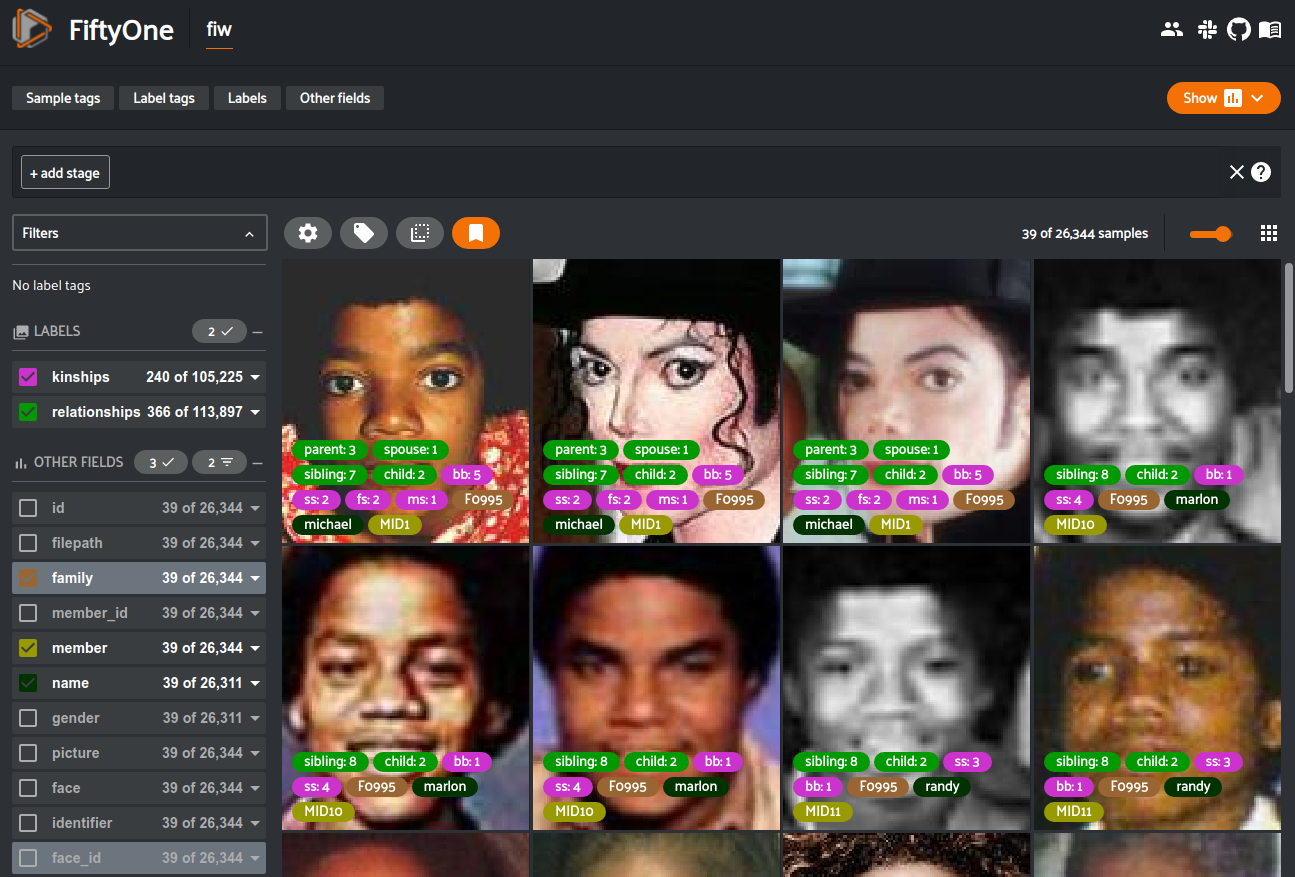Families in the Wild#
Families in the Wild is a public benchmark for recognizing families via facial images. The dataset contains over 26,642 images of 5,037 faces collected from 978 families. A unique Family ID (FID) is assigned per family, ranging from F0001-F1018 (i.e., some families were merged or removed since its first release in 2016). The dataset is a continued work in progress. Any contributions are both welcome and appreciated!
Faces were cropped from imagery using the five-point face detector MTCNN from various phototypes (i.e., mostly family photos, along with several profile pics of individuals (facial shots). The number of members per family varies from 3-to-26, with the number of faces per subject ranging from 1 to >10.
Various levels and types of labels are associated with samples in this dataset. Family-level labels contain a list of members, each assigned a member ID (MID) unique to that respective family (e.g., F0011.MID2 refers to member 2 of family 11). Each member has annotations specifying gender and relationship to all other members in that respective family.
The relationships in FIW are:
===== =====
ID Type
===== =====
0 not related or self
1 child
2 sibling
3 grandchild
4 parent
5 spouse
6 grandparent
7 great grandchild
8 great grandparent
9 TBD
===== =====
Within FiftyOne, each sample corresponds to a single face image and contains primitive labels of the Family ID, Member ID, etc. The relationship labels are stored as multi-label classifications, where each classification represents one relationship that the member has with another member in the family. The number of relationships will differ from one person to the next, but all faces of one person will have the same relationship labels.
Additionally, the labels for the
Kinship Verification task
are also loaded into this dataset through FiftyOne. These labels are stored
as classifications just like relationships, but the labels of kinship differ
from those defined above. For example, rather than Parent, the label might be
fd representing a Father-Daughter kinship or md for Mother-Daughter.
In order to make it easier to browse the dataset in the FiftyOne App, each
sample also contains a face_id field containing a unique integer for each
face of a member, always starting at 0. This allows you to filter the face_id
field to 0 in the App to show only a single image of each person.
For your reference, the relationship labels are stored in disk in a matrix that provides the relationship of each member with other members of the family as well as names and genders. The i-th rows represent the i-th family member’s relationship to the j-th other members.
For example, FID0001.csv contains:
MID 1 2 3 Name Gender
1 0 4 5 name1 f
2 1 0 1 name2 f
3 5 4 0 name3 m
Here we have three family members, as listed under the MID column (far-left). Each MID reads across its row. We can see that MID1 is related to MID2 by 4 -> 1 (Parent -> Child), which of course can be viewed as the inverse, i.e., MID2 -> MID1 is 1 -> 4. It can also be seen that MID1 and MID3 are spouses of one another, i.e., 5 -> 5.
Note
The spouse label will likely be removed in future version of this dataset. It serves no value to the problem of kinship.
For more information on the data (e.g., statistics, task evaluations, benchmarks, and more), see the recent journal:
Robinson, JP, M. Shao, and Y. Fu. "Survey on the Analysis and Modeling of
Visual Kinship: A Decade in the Making." IEEE Transactions on Pattern
Analysis and Machine Intelligence (PAMI), 2021.
Details
Dataset name:
fiwDataset source: https://web.northeastern.edu/smilelab/fiw/
Dataset license: https://fulab.sites.northeastern.edu/fiw-download
Dataset size: 173.00 MB
Tags:
image, kinship, verification, classification, search-and-retrieval, facial-recognitionSupported splits:
test, val, trainZooDataset class:
FIWDataset
Note
For your convenience, FiftyOne provides
get_pairwise_labels()
and
get_identifier_filepaths_map()
utilities for FIW.
Example usage
1import fiftyone as fo
2import fiftyone.zoo as foz
3
4dataset = foz.load_zoo_dataset("fiw", split="test")
5
6session = fo.launch_app(dataset)
fiftyone zoo datasets load fiw --split test
fiftyone app launch fiw-test
